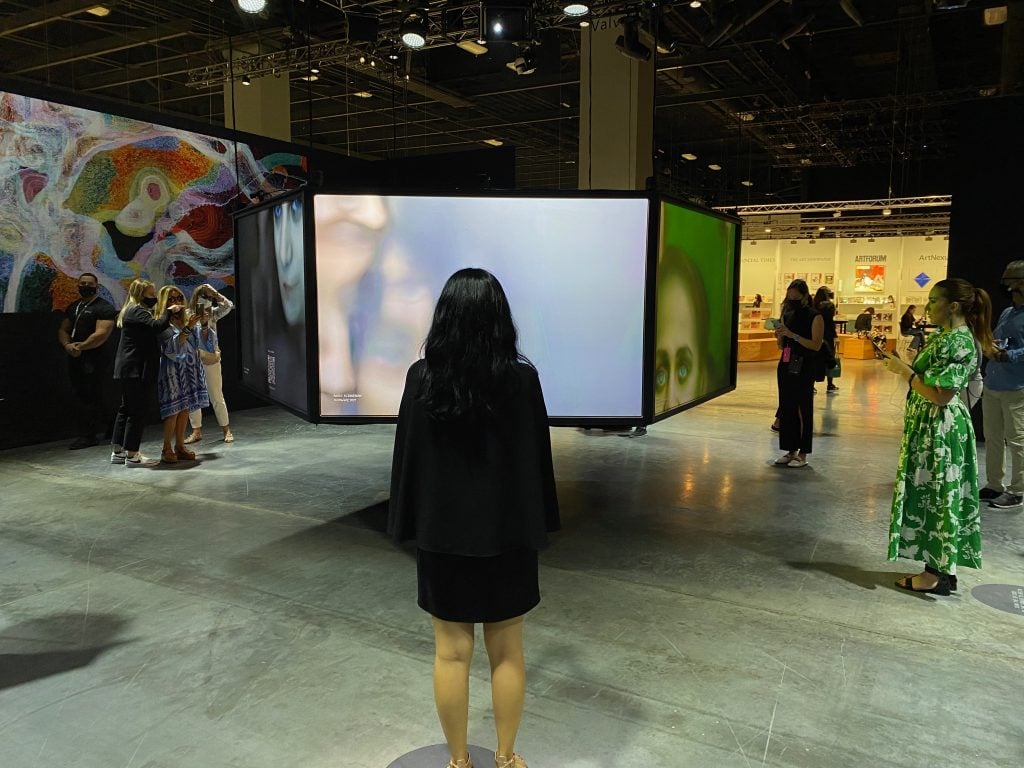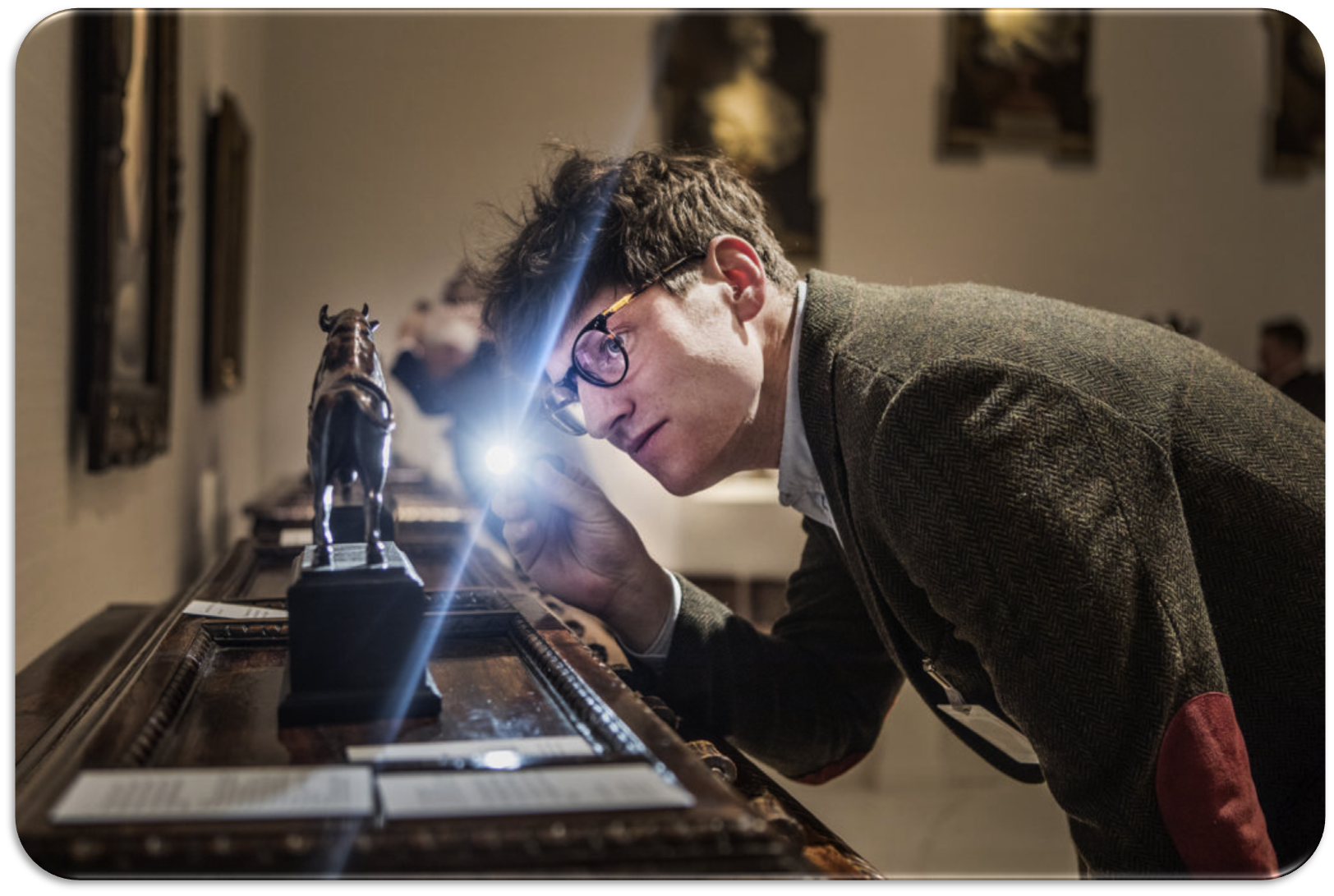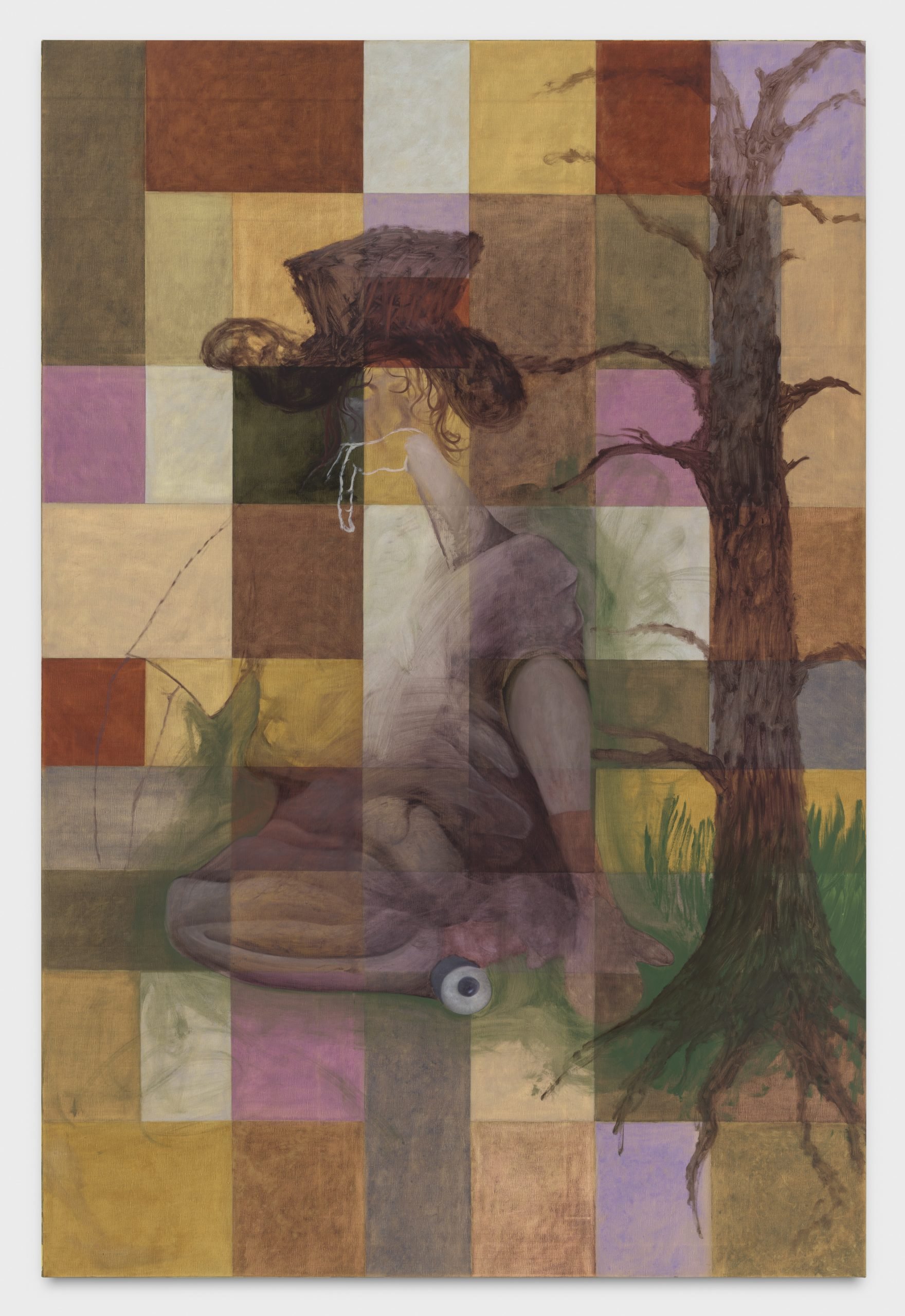Every Wednesday morning, Artnet News brings you The Gray Market. The column decodes important stories from the previous week—and offers unparalleled insight into the inner workings of the art industry in the process.
This week, refining my priors…
DÉJÀ VU ALL OVER AGAIN
Back in 2018, I spent the opening days of Miami Art Week using what I’d learned about blockchain technology in the preceding year to try to make sense of the crossover between the crypto space and the art world. My grand takeaway (cemented during what I described at the time as “an occasionally revelatory, sometimes exasperating, frequently surreal” five-hour conference organized by collector and dealer Adam Lindemann) was that the art establishment needed to do far more homework on the underlying technology if it hoped to achieve anything resembling the utopian vision of redistributed power and democratic access preached by blockchain evangelists.
Fast forward three years to December 2021 and, you guessed it, I’ve spent the opening days of Miami Art Week using what I’ve learned about blockchain tech since the ignition of this year’s NFT boom to try to make sense of the crossover between the crypto space and the art world.
For the optimists in the audience, my latest Miami trek confirms that the two ecosystems have certainly crept nearer to one another lately. They’ve even managed to manifest a few collaborations that feel genuinely organic and thoughtful. However, based on what I’ve seen and heard, it would be wise of people on both sides to temper their expectations for how comprehensive the merger will be, and how quickly it will proceed. In short, things aren’t going to get any simpler.
And yet, at least among the art world constituency paying more than passing attention to crypto, the predominant narrative holds that the two spaces have traveled a linear path toward one another, becoming more and more integrated with every passing year. It would now be fairly easy to cherrypick evidence to back up that storyline.
Art Basel Miami Beach and most of the satellite fairs in 2018 either hosted either no actual blockchain-based artworks and projects or only ones so minor I have no memory of them (despite having had my antennae very much up for their frequencies). The most substantial confluence between crypto and the art industry three years ago was the conference I mentioned earlier, a one-day affair featuring the likes of Pace Gallery’s Marc Glimcher, super-curator Hans Ulrich Obrist, New Museum director Lisa Phillips, and artist Ian Cheng.
The landscape is vastly different in 2021. Art Basel has dedicated a booth and a three-day series of live talks to Tezos, an open-source, energy-efficient blockchain network where scores of curatorially recognized media artists have tokenized their works over the years. The centerpiece of the booth is a multiscreen installation that allows visitors to add their algorithmically distorted self-portrait to works by generative artist Mario Klingemann (AKA Quasimondo), then mint the results as NFTs on the Tezos blockchain.
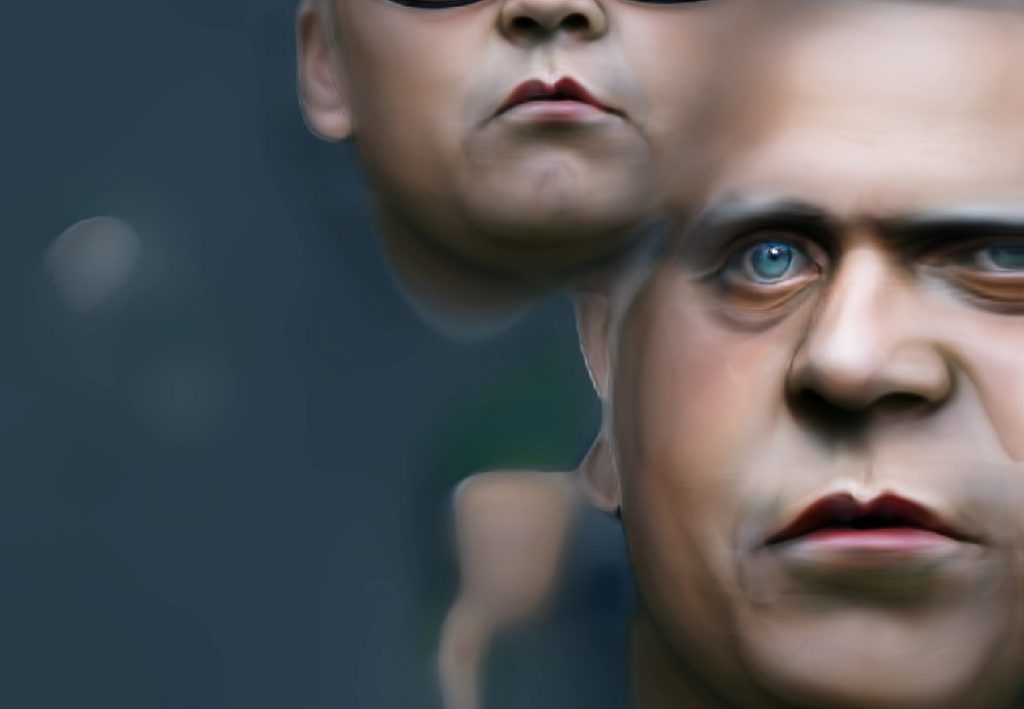
Mario Klingemann x the Gray Market, the first work I’ve tokenized courtesy of the Tezos booth at Art Basel Miami Beach 2021. Photo by Tim Schneider.
Multiple galleries at ABMB this year are also offering NFTs on their stands. Galerie Nagel Draxler devoted much of its booth to a showstopping group installation of tokenized multimedia works led by Kenny Schachter. It’s a sequel to the gallery’s successful crypto presentation at Art Basel’s flagship fair in September, and a preview of its plans to transform the smaller of its two Berlin spaces into a dedicated venue for NFT-backed works. (The first show there will be a solo by Schachter opening January 14.) Anchored by a giant LED screen displaying a Kenny avatar interacting with a metaverse environment custom-designed by Patrick Schumacher of Zaha Hadid Architects and metaverse platform Journee, the booth is brash, unapologetic, madcap fun—not adjectives that tend to be prevalent in descriptions of Art Basel’s usual fare.
A few aisles over, Pace, among the bluest of the blue-chip dealers, took a softer approach by featuring a collaborative work by Drift and D.J./crypto-artist Don Diablo called Block Universe (2021) on one of its exterior walls. The piece consists of three components: an NFT-backed digital video with custom soundscape, a physical installation, and an augmented-reality experience activated by the physical installation. The work was priced at a hefty $500,000. (It was still available by late afternoon of the fair’s first preview day.)
Pace Verso, the mega-gallery’s in-house crypto platform, also dropped two NFT-backed works by Glenn Kaino this Monday; one of them, Invisible Man (2021), a digitally rendered adaptation of his identically titled sculpture of Olympian and civil-rights activist Tommie Smith, sold for $50,000 the same day.
Crypto’s infiltration of the art establishment also stretched beyond the main expo. NFT-backed works were available in at least two booths inside the Untitled art fair’s return to Miami Beach. There, New York-based new-media specialist Bitforms is showing tokenized pieces by an array of artists including Refik Anadol, Claudia Hart, Jonathan Monaghan, and Addie Wagenknecht. The New York- and Miami-based consultancy Hayworth featured NFT-backed video work by Lans King.
If that weren’t enough, Christie’s has partnered with the NFT Now platform to present “The Gateway,” a pop-up exhibition of tokenized artworks curated into an abandoned bank in downtown Miami. And Tuesday night boasted a raucous launch party and temporary exhibition at the Faena Hotel complex for Aorist, a self-described “next-generation cultural institution” offering an eco-conscious NFT marketplace.
It’s… a lot. Compare all the examples above to Miami Art Week 2018, and it’s not hard to plot out a storyline of linear integration between the art establishment and the crypto space. I just worry that that narrative, like so many other good ones, is more myth than reality. It also has tremendous implications for where the road leads next.
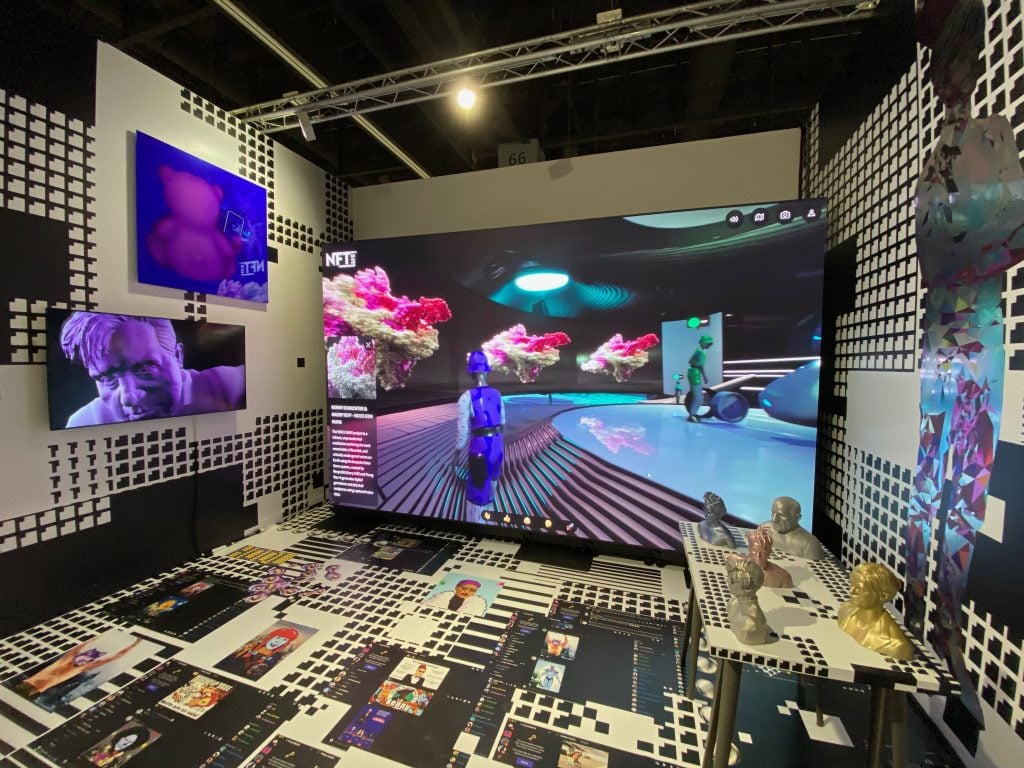
Installation view of the NFT-focused portion of Galerie Nagel Draxler’s booth at Art Basel Miami Beach 2021. Photo by Tim Schneider.
O, INVERTED WORLD
What’s left out of the simple, satisfying narrative of continuous art-and-crypto evolution is what happened between January 2019 to early 2021: a whole lot of nothing. This isn’t to say that select artists, startup founders, gallerists, curators, and diamond-handed cryptocurrency holders abandoned the blockchain during that stretch. But most of the rest of the art industry did.
As an art journalist who had been targeted by seemingly every blockchain-based press release produced in 2018, trust me when I tell you that I barely heard shit about crypto in my Artnet News inbox for two solid years afterward. It wasn’t until NFTs started going bananas early this year—a direct result of cryptocurrency prices shooting up an Everest-like peak—that the interest (and the pitches) came roaring back. (Since January, the price of bitcoin is up 80 percent, to about $57,000, and the price of ether is up eightfold, to roughly $4,700.)
But don’t just take my word for it. Jonathan Perkins, one of the cofounders of the now massive NFT platform SuperRare, told me that the company “basically operated on a zero-dollar budget” for the two years ending in 2020 due to the sleepiness of the market.
The crypto space is no closer to being a monolith than the art world is. The more I learn about each, the more nuance feels necessary to legitimize any analysis of either. Their differences outweigh their similarities—tokenizing visual art, after all, is only one use case for the multipurpose blockchain—so it seems naïve to expect that the many respective moving parts of each will simply slide together and lock into place like puzzle pieces just because they share some traits in some situations.
I’ll go even further. A few weeks ago, I wrote after the NFT.NYC conference that art and crypto were parallel worlds. I still believe that’s true in some respects. But Miami Art Week 2021 has also crystallized multiple ways in which the art world is a direct inversion of the crypto space (and vice versa), spanning everything from pricing and market-making power, to scheduling and VIP status. It isn’t just that things work differently from one niche economy to the other; it’s that they work exactly backwards.
This was one of the themes of a conversation I had with Micol Ap, founder of startup Vertical Crypto Art and one of the speakers in Art Basel’s Tezos programming. Ap’s company seeks to distinguish itself by prioritizing curation, storytelling, and education in its myriad blockchain-based activities, which include an advisory service, bespoke auctions, and a 12-week online residency for artists seeking to dig deeper into NFTs.
“That Tezos is at Art Basel Miami Beach is a great stepping stone in the direction this ecosystem is taking. That exhibitors at the fair are talking about NFTs is a great sign. But there might always be a divide between the two worlds,” she said.
Nowhere is this more evident than in NFT valuations. There is still relatively little crossover between the buyers spending ether to cop NFTs on third-party exchanges and those buying through nascent art-world platforms. The two communities’ priorities are so different that moving from one space to the other almost demands that an artist start over from square one when it comes to connecting with patrons and building up a presence (or, if you prefer, a brand).
“I don’t think crypto buyers care how much you sold for in the traditional art market,” Ap said. In fact, if you already have standing within the art establishment, you’re “almost putting yourself at risk” by pivoting into crypto.
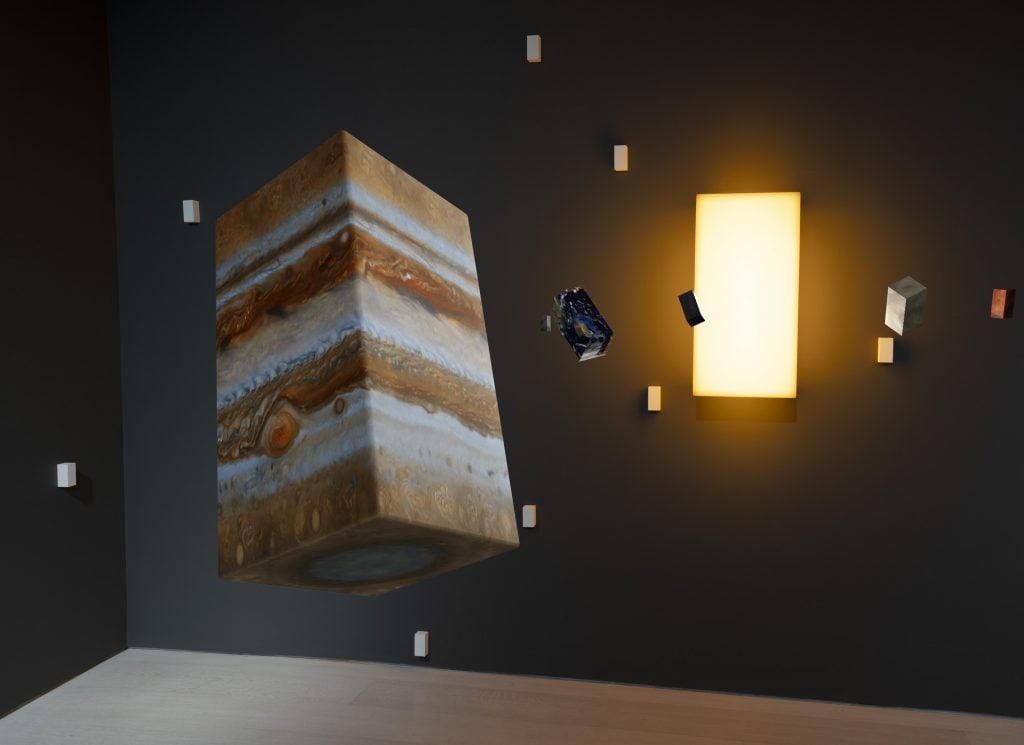
DRIFT, Block Universe (2021). © DRIFT. Courtesy of Pace Gallery.
For comparison, NFTs by digital-native creators like Beeple (A.K.A. Mike Winkelmann), Larva Labs (of CryptoPunks fame), and XCopy regularly sell for millions, while NFTs by even the most popular traditional blue-chip artists sell for a fraction as much. As of my writing, 24 “Rocket Factory” NFTs by Tom Sachs were being resold on Opensea for prices under 2.5 ETH (around $11,750 based on current exchange rates). Pace Verso’s first official drop consisted of five unique tokenized works by Lucas Samaras, all sold for just $10,000 each. (Christiana Ine-Kimba Boyle, Pace’s online sales director, said that the platform will offer another grouping of unique Samaras NFTs at double the price in January.) Even Glenn Kaino’s $50,000 Invisible Man is a modest entry in the annals of tokenized artwork prices.
This raises a vital question about the market relationship between crypto-native artists and the art establishment: Who needs who more right now? This is not a dig at Pace Verso or any traditional artists entering the crypto space. Prices are only one arbiter of value, of course, and there’s a lot to be said for slow, steady, sustainable growth instead of volatile rocket fuel.
Still, in this context, the $500,000 price of the Drift x Don Diablo work in Pace’s booth seems noteworthy. No doubt it partly comes from the multi-component reality of the piece—it is still a supercharged Drift sculpture, after all—but I also have to imagine that Diablo’s demand among dedicated NFT buyers is a contributing factor.
At ABMB’s preview days, the top-level art VIPs can’t share space with the top-level crypto VIPs by design. Despite NFTs’ larger than usual footprint at the fair this year, the only people able to see it Tuesday were as establishment-approved as it gets: museum trustees, high-powered advisors and their wealthiest clients, a few institutional directors. Ine-Kimba Boyle said that the gallery wasn’t expecting its more crypto-native VIPs until Wednesday due to conference scheduling conflicts. They seem to have been worth the wait, too, as the gallery announced before Wednesday’s end that a new client had acquired the piece and would loan it to a European institution, while also paying an extra $50,000 donation to Justdiggit, a re-greening nonprofit that was already scheduled to receive 10 percent of the half-million-dollar sales price.
No wonder the bulk of the Tezos program takes place Thursday and Friday afternoon, after Miami’s biggest non-art crypto conference (Dcentral) will have ended, and the blockchain crowd will still be in town to shuttle between other events like Samsung Next’s NFT IRL and the BitBasel music and NFT experience.
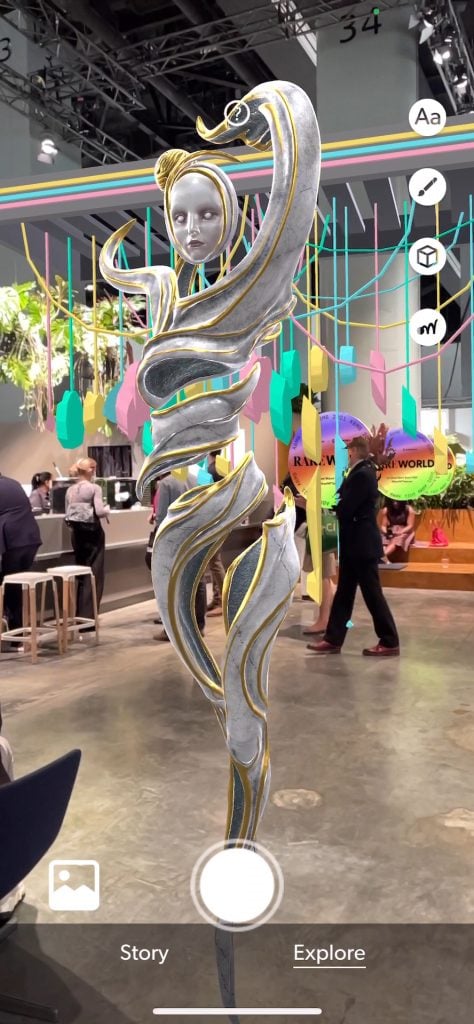
Installation view of augmented reality works by Dom Qwek (foreground) and Brian Brinkman (background), installed without Art Basel’s cooperation at the 2021 edition of the Miami Beach fair. Courtesy SuperRare and Superworld.
This friction is especially evident in a little digital gate-crashing by the crypto crowd. From Tuesday through the weekend, SuperRare and virtual real-estate platform SuperWorld partnered to produce an unauthorized augmented-reality takeover of ABMB’s venue. The guerrilla project (which earned the two platforms a cease-and-desist order from Art Basel within 24 hours) encompasses 20 3D-rendered sculptures peppered around the Miami Beach Convention Center, visible through SuperWorld’s A.R. smartphone app. The works will all be sold in an online reserve auction on SuperRare during Miami Art Week.
“In terms of inspiration, these types of art fairs oftentimes leave certain people feeling left on the sidelines, or like you need to be part of the insiders’ club,” SuperRare’s Perkins said. “With NFTs and A.R., there’s a spirit of inclusion and permissionlessness, and we thought it was a great opportunity to play around with that, build a virtual layer on top, and allow more people into the party.” Only, it turns out, the parents swooped in to shut the soiree down early.
In other words, some members of the art establishment may be warming up to crypto, but it’s hardly a universal hearts-aflame situation. I doubt it ever will be, or even that the passion will rise steadily and spread out widely as the future marches on. Given that the prices of cryptocurrencies swing more wildly and impact buying more dramatically than traditional macroeconomic cycles, let’s see how committed traditional dealers, auction houses, and art fairs are when bitcoin, ether, and the rest take their next extended market plunge.
Still, make no mistake: NFTs and crypto are too firmly entrenched and too powerfully funded to go away now. But that doesn’t mean their progress through the art world will be linear or limitless. Prepare for more switchbacks, inclines and crosswinds on the road ahead, because even getting to this point took more stopping and starting than revisionist storytelling would suggest.
That’s all for this week. ‘Til next time, remember: History doesn’t repeat itself, but it does rhyme.
Follow Artnet News on Facebook:
Want to stay ahead of the art world? Subscribe to our newsletter to get the breaking news, eye-opening interviews, and incisive critical takes that drive the conversation forward.
